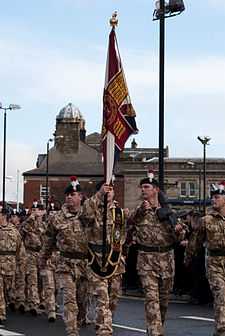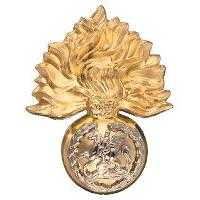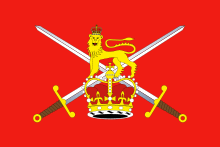Royal Regiment of Fusiliers
| Royal Regiment of Fusiliers | |
|---|---|
|
Cap Badge of The Royal Regiment of Fusiliers | |
| Active | 23 April 1968-Present |
| Allegiance |
|
| Branch |
|
| Type | Line Infantry |
| Role |
1st Battalion - Armoured Infantry 5th Battalion - Army Reserve |
| Size | Two Battalions |
| Part of | Queen's Division |
| Garrison/HQ |
RHQ - London 1st Battalion - Tidworth 5th Battalion - Durham |
| Nickname |
The Shiners The Old and the Bold Lord Wellington's Bodyguards |
| Motto | "Honi soit qui mal y pense" (French) "Shame on him who thinks ill of it" |
| Colors | Gosling green flag with Ancient badges St George Killing the Dragon centered, motto in scroll Quo Fata Vocant, united rose surmounted by crown in three corners, V with Union in canton |
| March |
Quick - The British Grenadiers Slow - Rule Britannia |
| Mascot | Indian Blackbuck (Bobby) |
| Anniversaries | St. George's Day (23 April), Minden (1 August) |
| Commanders | |
| Colonel in Chief | HRH The Duke of Kent, KG, GCMG, GCVO |
| Colonel of the Regiment | Brigadier Trevor J Minter, OBE DL |
| Insignia | |
| Tactical Recognition Flash |
 |
| Hackle |
Red over White From Royal Northumberland Fusiliers |
| Abbreviation | RRF |
The Royal Regiment of Fusiliers (RRF) is an infantry regiment of the British Army, part of the Queen's Division. As one of the existing large infantry regiments, the Royal Regiment of Fusiliers was largely unaffected by the reforms of the infantry that were announced in December 2004.
History
The regiment was formed on 23 April 1968, as part of the reforms of the army that saw the creation of the fourth 'large infantry regiments', by the amalgamation of the four English fusilier regiments:[1]
- The Royal Northumberland Fusiliers
- The Royal Warwickshire Fusiliers
- The Royal Fusiliers (City of London Regiment)
- The Lancashire Fusiliers
The RRF was formed to serve as the county regiment of the following counties:
 |
"The British Grenadiers"
"The British Grenadiers", the official Regimental Quick March of the Royal Regiment of Fusiliers, performed by the United States Army Band Strings ensemble |
| Problems playing this file? See media help. | |

The 3rd Battalion of the Regiment, equipped with 45 Armoured Personnel Carriers, saw active service in Iraq during the Gulf War in 1991.[2]
In 2003 elements of the 1st Battalion of the Regiment were deployed to Basra in Iraq where they carried out patrols and distributed water to the local population.[3]
The regiment received a reserve battalion, the 5th Battalion RRF, through the redesignation of Tyne-Tees Regiment, on 1 April 2006.[4]
In 2006 elements of the former 2nd Battalion of the Regiment were deployed to Afghanistan to support the International Security Assistance Force fighting off 150 Taliban attacks.[5]
Under Army 2020, there will only be the 1st Battalion in the regular army and it will re-roled as an armoured infantry battalion under 1st Armoured Brigade.[6] Due to a series of Government Defence Reviews, 'Options for Change' and the recent 'Strategic Defence Review' the regiment now comprises two regular battalions and a number of Army Reserve companies located in the four regimental areas. The 2nd Battalion amalgamated with the first battalion forming just one regular battalion, in September 2014, in the army 2020 plan.
Mascot
The regiment's mascot is an Indian Blackbuck Antelope. It is a tradition inherited from the Royal Warwickshire Fusiliers. The current mascot's name is Bobby and he holds the rank of Corporal. Bobby attends all major parades held by the regiment.[7]
Hackle
As a fusilier regiment, the RRF wears a hackle, which in this case is the hackle of the Royal Northumberland Fusiliers, red over white. This distinction was originally a white plume which His Majesty's Fifth Regiment of Foot had taken from the head dress of fallen French troops at St. Lucia in December 1778. The Fifth Regiment of Foot became His Majesty's Fifth (Northumberland) Regiment of Foot with the county affiliations of 1782. In 1829 King George IV ordered the white plume to be worn by all infantry regiments, and in order not to take away from the Fifth (Northumberland) Regiment of Foot's battle honour, their plume was distinguished by being made red over white.[8]
Battle honours
- Combined battle honours of The Royal Northumberland Fusiliers, The Royal Warwickshire Fusiliers, The Royal Fusiliers (City of London Regiment) and The Lancashire Fusiliers, plus:
- Wadi al Batin, Gulf 1991, Al Basrah, Iraq 2003
Order of precedence
| Preceded by Duke of Lancaster's Regiment |
Infantry Order of Precedence | Succeeded by Royal Anglian Regiment |
Lineage
| Lineage | |
| The Royal Regiment of Fusiliers | The Royal Northumberland Fusiliers |
| The Royal Warwickshire Fusiliers | |
| The Royal Fusiliers (City of London Regiment) | |
| The Lancashire Fusiliers | |
Alliances
 Canada - The Royal Canadian Regiment
Canada - The Royal Canadian Regiment Canada - The Lorne Scots (Peel, Dufferin and Halton Regiment)
Canada - The Lorne Scots (Peel, Dufferin and Halton Regiment) Canada - 31 Combat Engineer Regiment (The Elgins)
Canada - 31 Combat Engineer Regiment (The Elgins) Canada - The Royal Westminster Regiment
Canada - The Royal Westminster Regiment Canada - Les Fusiliers du St-Laurent
Canada - Les Fusiliers du St-Laurent Australia - The Royal Victoria Regiment
Australia - The Royal Victoria Regiment New Zealand - The Hauraki Regiment
New Zealand - The Hauraki Regiment Royal Navy - HMS Northumberland
Royal Navy - HMS Northumberland
See also
![]() Media related to Royal Regiment of Fusiliers at Wikimedia Commons
Media related to Royal Regiment of Fusiliers at Wikimedia Commons
- The Royal Highland Fusiliers
- The Royal Welch Fusiliers
- The King's Own Fusiliers
References
- ↑ Swinson, Arthur (1972). A Register of the Regiments and Corps of the British Army. London: The Archive Press. ISBN 0-85591-000-3.
- ↑ "Units in Operations Desert Shield and Desert Storm". Retrieved 26 April 2014.
- ↑ "Royal Regiment of Fusiliers in Basra, 22-23 April 2003". Imperial War Museum. Retrieved 26 April 2014.
- ↑ "Army engineers big change for Terriers". Evening Chronicle. 24 March 2006. Retrieved 26 April 2014.
- ↑ "Operation Veritas: British units deployed". Retrieved 26 April 2014.
- ↑ "Army 2020 Update, page 7" (PDF). Retrieved 26 April 2014.
- ↑ Ollington, Robin (2004). Bobby of the Fusiliers: The Story of Our Famous Regimental Mascot and Its Service and Adventures with Us for Over Two Hundred Years. Royal Regiment of Fusiliers. ISBN 9780954862909.
- ↑ "Royal Regiment of Fusiliers: Regimental history". Ministry of Defence. Retrieved 26 April 2014.
External links
| ||||||||||||||||||||
| ||||||||||

